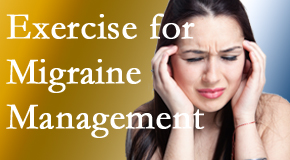Richmond Migraine Sufferers May Find Exercise and Chiropractic Help
Migraine is a draining condition for its sufferers. It’s costly in terms of pain, money, and pharmacological use necessity. Drugs are still the “gold standard” of care. Patients often request choices from their migraine healthcare providers for non-drug options. Richmond migraine sufferers want alternative ideas! Johnson Chiropractic suggests that exercise may be one such beneficial option.
EXERCISE FOR CHRONIC PAIN
Migraine is, for most Richmond migraine sufferers, a chronic pain condition. It is not usually a one time condition. Chronic pain disturbs the nervous system and the specific pain-generator. Researchers explained evidence that exercise helps a variety of chronic pain conditions including migraine directly and indirectly with a goal of changing the cycle of pain, sedentariness, and worsening disability. These changes don’t come overnight. They come with long-term, regular, individualized exercise bringing about improvement in pain and function. (1) Johnson Chiropractic reminds our Richmond chiropractic patients with all sorts of conditions that it’s slow and steady commitment that results in desired outcomes.
EXERCISE FOR MIGRAINE BEING STUDIED
Researchers and migraine sufferers alike hold out hope for a simple, low-cost approach to migraine care. For example, a recent comparison study of neck-specific exercise versus sham ultrasound to decrease the frequency and intensity of migraine attacks. (2) A new meta-analysis in Headache explained that aerobic exercise for migraine patients dropped the number of migraine days. (3) These are beneficial outcomes for Richmond migraine treatment.
EXERCISE BENEFITS: Overall and Migraine Specific
Richmond chiropractic patients are often urged to exercise. Exercise appears to be a recommended panacea for everything from back pain to migraine to depression to neck pain and so much more. Why? It works. Exercise stifles inflammation via reduction of inflammatory modulators (many cytokines) and stress hormones (growth hormone and cortisol). Exercise constructively impacts the microvascular system that possibly affects a certain type of cortical spreading depression. Migraine specifically, exercise helped migraine self-efficacy by allowing the migraine sufferer to have a sense of control which reduced migraine burden. How much exercise does this? “Sufficiently rigorous aerobic exercise” brought about statistically significant decrease in migraine frequency, intensity and duration. That’s appreciated by Richmond migraine sufferers! Of course, higher intensity exercise appears to bring about more benefit. Pharmacological drugs like topiramate were reported to be better than exercise, but including exercise into its use was suggested to be beneficial. Migraine sufferers who also have neck pain or tension headache are reported to benefit from exercise. Low impact is worthwhile if high impact exercise is not possible. (4) Johnson Chiropractic agrees with the researchers’ outcome: exercise is a practical evidence-based recommendation for migraine prevention.
CONTACT Johnson Chiropractic
Listen to this PODCAST with Dr. David Kulla on The Back Doctors Podcast with Dr. Michael Johnson as he describes how he followed The Cox® Technic System of Spinal Pain Management for his patient with migraine which incorporated Cox® Technic spinal manipulation as well as exercise for appreciated relief by his patient.


